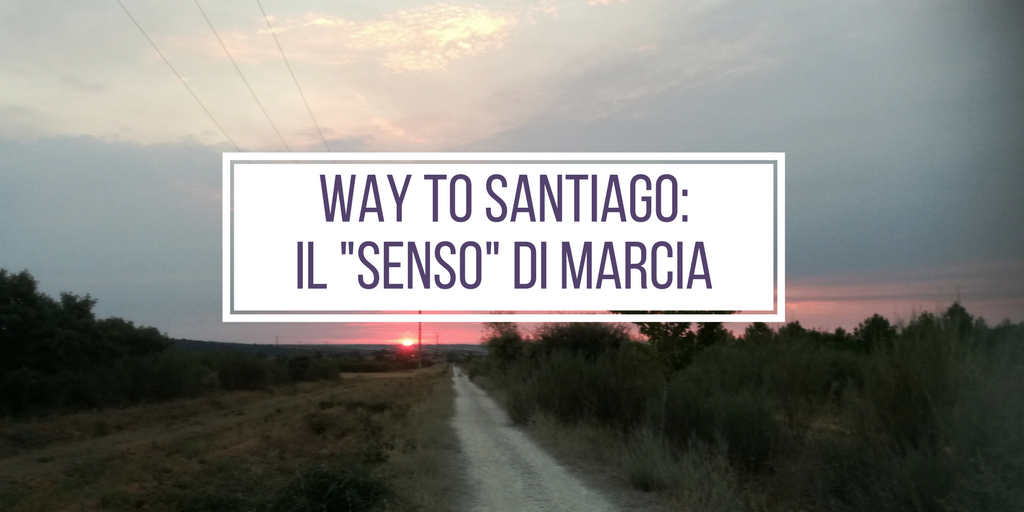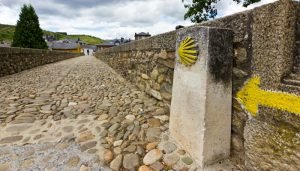Way to Santiago #1: The “Direction” of travel
[Original article by Claudia Agrestino]
There are travels with a precise destination, that start with a specific aim; other travels do not have a destination, but they have an aim, and this is the main reason for leaving. Nothing more than this. Then, there are trips that naturally have a destination, an essential one, but with an unknown purpose: who knows if and when it will show up. This kind of trip can change your entire existence, and I learnt it the hard way, fortunately. These are the true travels in one’s life, those that are more and more remembered over time, when you look behind, instead of being slowly forgotten. It is all about that kind of experience that you struggle to describe, since it seems impossible to find the right words: it almost seems like that feeling you have when you wrong somebody, or worst, it feels like committing a disgusting crime by trying to crystallize certain moments in order to stuck them somewhere, forever, being this somewhere the pages of a diary, a book, a newspaper, a Facebook or Instagram post, a hashtag. In these cases, starting the trip is the simple part, coming back home is the true achievement. You feel dizzy, lost, confused: the bed you slept in before leaving suddenly becomes very uncomfortable, your shoes and jeans are too tight, water tastes like nothing, neighbours are strangers, family members just relatives, your mobile phone is useless. A creature in discomfort in the same world in which it used to live in the easiest way possible; everything seems to be so different from what it was before, that you don’t recognize it: suddenly you get dull, passive, doing anything becomes unbearable. Walking down the streets becomes difficult, because you mostly hit people that walk too slowly or bicycles that go too fast. Interacting with people is a problem too, because you’d want to say hello to everyone, or simply wish a good day, but everyone’s too into obligations, tiredness, everyday life and hardly looks up, and if someone does, they look down right after doing so. You’re a stranger in your own world: in the beginning you feel like you shrinked so much that you became invisible, and suddenly regret leaving. Why should one ruin himself so much? It’s just after some week or, like in my case, some months, that you start realizing the benefits.
Exactly five months have passed since I came back to Italy, after spending two weeks away from the world, metaphorically speaking, during one of the most challenging and rewarding travels I’ve ever made (up to now, I mean). It has been so challenging that I just recently started to recover, in mind and body, and now I try to write about it, since I still haven’t managed to speak about it as I thought I’d do. As I was saying, words sometimes seem to be unable to come out. So this column will be more like a travel diary than a guide. A travel diary that will be a way, for me, to restore my memories of what this trip has been, and a guide for you, that will let you know about something that you could never have discovered without it. Or, at least, not as I did.
According to the legend, the cathedral of Santiago de Compostela, one of the most famous places of pilgrimage in Europe, would have been built right in the place in which the apostle James was buried after his death, happened in 40 a.D., after he was brought in this western land from Jerusalem, on a boat sailed by an angel. Here is the reason why the name is called Santiago: San Tiago is the spanish for St. James. The second piece of the name, “de Compostela”, comes from what happened centuries after his burial, that is the origin of the pilgrimage itself: Pelayo, in 813 a.D., discovered this location following, during his travel, a shower of stars that gave the area the name of Campus Stellae, and so the stars are the symbol, together with little yellow arrows, that pilgrims follow during their path.
When you leave for Santiago you would take everything with you, because you think that everything is surely not what you normally use. I flew on a plane to Spain with 7 kg on my back, thinking that it was nothing, and without knowing that I would have come back with a lot less weight: on my back, in my body, in my heart. A 40 litres backpack, a rod to balance my movements and two boots: the perfect pilgrim’s kit.
Milano-Bergamo airport, flight to Madrid-Barajas at 6:45. At the gate 21 there are four girls dressed in a funny way, with colours that seem to come from the 80ies and four layers of clothes (obviously: how could we know what the weather would be like in a place in which we never were, in another country, thousands of miles away?) are boarding their luggage while being so enthusiastic that the passengers that just want to get on board and sleep are probably annoyed. A pack of paprika chips, a needed toilet tour, some chatting… and suddenly it is time to get on board. Two hostesses in a rant, and with messy hair welcome us on board: they don’t speak a single word in italian or english. “Fortunately I studied some spanish when I was in highschool”, I think and I can now state it for sure, I couldn’t have produced a better thought. Two hours later the plane is landing: from the portholes you can see the spanish landscape, with its fields and its brick coloured soil. Putting a foot outside of the main exit on the unstable little stair is enough to understand that something has already changed, and nothing will be the same in the next days. Already from the beginning. Pieces of cloth and foam rubber all around the luggage carousel suggest me that not even my backpack had a quiet flight. Torn apart by a bear? Lighted on fire? Attempted suicide? Who knows. Surely, it is a big problem: facing the Santiago Walk without a backpack… clearly a hard challenge. Fortunately I’m not alone, and with my mates’ support, after the obvious stop at the claims office, I manage to get a new backpack, even better than the previous one. “¡bendito sea el Corte Inglés!” (a sort of big shopping centre, ed.), and finally take the bus that will lead us to Leòn, in Castilla, starting point of our Walk.
340 kilometres. Many? Few? It depends on the points of view. About half of the entire route, that creates the so-called “french way”. “A nice walk” will some think; “yes but not even the full one”, will think some others. The truth is that since the first kilometre I haven’t been asking myself nothing but if the Santiago Walk would have had the same importance and the same meaning to me, since I was walking down just a part of that extremely long route. I was feeling inappropriate at first, even maybe ashamed of not having had the guts for starting from France. I was starting without cutting across the Pyrenees, going through the feared mesetas, seeing the beautiful Pamplona to arrive in Castilla. Instead of being fresh and rested, I would have had blisters on my feet, and my eyes already full of memories.
But now I know, after all the kilometres, the landscapes, the people I met, that the Camino has a reason to be for everyone, regardless of how long it lasts and how long it is, it has its meaning, and you can fully understand it just by looking behind you and by travelling over it again, step by step.
I will try to travel over it with you, during the next weeks.





